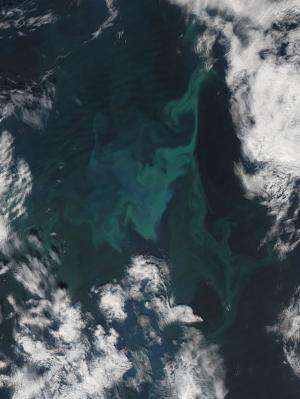Image: Phytoplankton Bloom in the Norwegian Sea

(Phys.org) —The waters off Iceland rank among the world's most productive fisheries. The reason for the abundance is an ample supply of phytoplankton, the base of the marine food chain. Like any plant, microscopic phytoplankton need sunlight and nutrients to survive. Iceland's coastal waters offer both during the long days of summer.
The Moderate Resolution Imaging Spectroradiometer (MODIS) flying aboard NASA's Aqua satellite acquired this true-color image of a large phytoplankton bloom in the Norwegian Sea, off of Iceland, on July 6, 2013. The range of colors from milky blue to green suggests that a range of different species make up this bloom, most likely including diatoms and perhaps chalky white coccolithophores, says Sergion Signorini, and ocean scientist at NASA Goddard Space Flight Center.
Floating in the water, phytoplankton act like tracers, revealing the course of mixing currents and the swirling eddies where they clash. A branch of the North Atlantic Current (the Gulf Stream) flows north, bringing warm Atlantic water to mix with the cold Arctic currents circling in from the east.
Provided by NASA




















